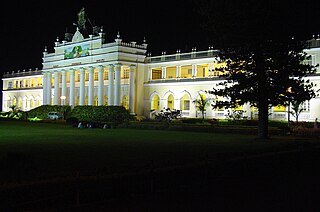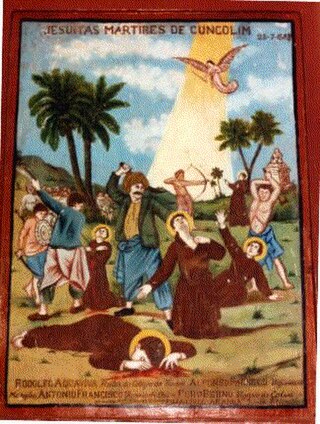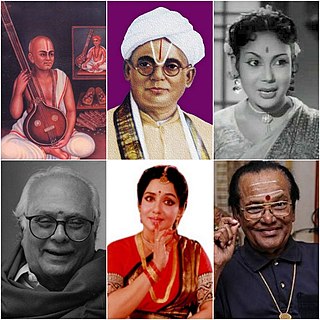Related Research Articles

Bombay State was a large Indian state created in 1950 from the erstwhile Bombay Presidency, with other regions being added to it in the succeeding years. Bombay Presidency was merged with the princely states of Baroda, Western India and Gujarat and the Deccan States.

Khatri is a caste originating from the Malwa and Majha areas of Punjab region of South Asia that is predominantly found in India, but also in Pakistan and Afghanistan. The Khatris claim they are warriors who took to trade. In the Indian subcontinent, they were mostly engaged in mercantile professions such as banking and trade. They were the dominant commercial and financial administration class of late-medieval India. Some in Punjab often belonged to hereditary agriculturalist land-holding lineages, while others were engaged in artisanal occupations such as silk production and weaving.

The University of Mysore is a public state university in Mysore, Karnataka, India. The university was founded during the reign of Maharaja Krishnaraja Wadiyar IV and the premiership of Sir M. Visvesvaraya. The university is recognised by the University Grants Commission for offering higher studies degree courses on-campus as well as online. It was inaugurated on 27 July 1916. Its first chancellor was the maharaja himself; the first Vice-Chancellor was H. V. Nanjundaiah. This was the first university outside of British administered Indian provinces, the sixth in the Indian subcontinent as a whole, and the first in Karnataka. It is a state university of the affiliating type, and was deemed autonomous within the Republic of India on 3 March 1956, when it gained recognition from the University Grants Commission.

Saurashtra is an Indo-Aryan language spoken primarily by the Saurashtrians of Southern India who migrated from the Lata region of present-day Gujarat to south of Vindhyas in the Middle Ages.
Deshastha Brahmin is a Hindu Brahmin subcaste mainly from the Indian state of Maharashtra and North Karnataka. Other than these states, according to authors K. S. Singh, Gregory Naik and Pran Nath Chopra, Deshastha Brahmins are also concentrated in the states of Telangana (which was earlier part of Hyderabad State and Berar Division), Andhra Pradesh and Madhya Pradesh (Which was earlier part of Central Provinces and Berar) Historian Pran Nath Chopra and journalist Pritish Nandy say, "Most of the well-known saints from Maharashtra, Karnataka and Andhra Pradesh were Deshastha Brahmins". The mother tongue of Deshastha Brahmins is either Marathi, Kannada or Telugu.
The Nayak, or Naik is a historic Indian title conferred on military generals and governors of feudal states in the Middle Ages. Today it is also a surname. Nayaks are mostly Hindu and few Sikhs, who follow Hinduism and Sikhism respectively.

Talakadu Srinivasaiah Nagabharana, commonly known as T. S. Nagabharana, is an Indian film director, in the Kannada film industry and a pioneer of parallel cinema. He is one of the few film directors to have straddled the mainstream and parallel cinema worlds.
Kutch Gurjar Kshatriya are a minority Hindu community of Gujarat in India, who claim to be Kshatriyas. They are an artisan community related with masonry, artistic carvings, sculpting and building and construction works. They are also known as the Mistri or Mistris of Kutch.
Gurjar Kshatriya are a Hindu community mostly in Gujarat and Maharashtra. They are artisan community, occupation is masonry work.

Roman Catholic Kshatriyas are a modern Christianised caste among Goan, Bombay East Indian, Mangalorean, Kudali & Karwari Catholics. They are patrilineal descendants of Kshatriya and Vaishya Vani converts to the Latin Church, in parts of the Konkan region that were under Portuguese Goan rule. They are known as Chardo in Goan Konkani, Charodi in Canarese Konkani & as Sandori or Vadval in Damanese and Mahraashtrian Konknni, while others also identify as Bhandari or Khatri in their Bombay East Indian dialects.

The Saurashtra people, or Saurashtrians, are an Indo-Aryan ethno-linguistic Hindu Brahmin community of South India who speak the Saurashtra language, an Indo-Aryan Gujarati language, and predominantly reside in the Indian states of Tamil Nadu, Kerala, Andhra Pradesh and Karnataka.
The Rudrapatnam Brothers are an Indian Carnatic vocal duo, consisting of brothers R. N. Thyagarajan and Dr. R. N. Tharanathan. The brothers come from a family of musicians from Rudrapatna village off the Kaveri banks in Arkalgud Thaluk of Hassan district in the southwest Indian state of Karnataka. Vocalist Tiger Varadachariar, on seeing the musical atmosphere there, once claimed that "Rudrapatnam is the Thanjavur of Karnataka". Music, Veda adhyayana, and studying Sanskrit were integral parts of their family tradition.

About 25,000 inscriptions found in Karnataka and nearby states belong to historic Kannada rulers, including the Kadambas, the Western Ganga Dynasty, the Rashtrakuta, the Chalukya, the Hoysala and the Vijayanagara Empire. Many inscriptions related to Jainism have been unearthed. The inscriptions found are generally on stone (Shilashasana) or copper plates (Tamarashasana). These Kannada inscriptions are found on historical hero stones, coins, temple walls, pillars, tablets and rock edicts. They have contributed towards Kannada literature and helped to classify the eras of Proto Kannada, Pre Old Kannada, Old Kannada, Middle Kannada and New Kannada. Inscriptions depict the culture, tradition and prosperity of their era. The literature of Ramayana and Mahabharata are transferred through the generations by these inscriptions. The Hazara Rama Temple and Aranmula Parthasarathy Temple are the best examples of temples associated with Kannada inscriptions.

Madhva Brahmins, are Hindu Brahmin communities in India, who follow Sadh Vaishnavism and Dvaita philosophy propounded by Madhvacharya. They are found mostly in the Indian states of Karnataka, Maharashtra, Goa, Tamil Nadu, Kerala, Telangana and Andhra Pradesh.
Sahebzada Syed Mansoor Ali Tipu is a social worker and the national president of Tehrik-e-Khudadaad. Belonging to the family of the Tipu Sultan, former ruler of Mysore, he is a seventh generation descendant of Tipu Sultan. As a researcher, major part of his work is to keep the family legacy alive and provide factual information about the family history and Tipu Sultan. Mansoor regularly participates in political debates concerning Tipu's image and work for the welfare of various communities. He also works for the communal and regional peace in the southern and western part of India in the states of Karnataka, Tamil Nadu, Maharashtra and Kerala. Syed Mansoor became a political figure when he demanded reservation for Muslim and Marathas, joining Sambha Ji Forces

Ibrahim Sutar was an Indian social worker and poet known for folk-music performances across Karnataka and neighboring states which spread the message of Hindu–Muslim communal unity.
Madhva Vaishnavas or Sadh Vaishnavas or Madhvas are Hindu communities in India, who follow Sadh Vaishnavism and Dvaita philosophy propounded by Madhvacharya. They are found mostly in the Indian states of Karnataka, Maharashtra, Goa, Tamil Nadu, Kerala, Telangana and Andhra Pradesh.
Marasimha II Satyavakya was a king of the Western Ganga Dynasty, 23rd in the succession. He was the successor of Marulaganga Neetimarga, his half-brother who reigned 961–963. He was succeeded by Rachamalla IV Satyavakya, his eldest son. He was a vassal of the declining Rashtrakuta empire and served them until their collapse.

Moily ministry was the Council of Ministers in Karnataka, a state in South India headed by M. Veerappa Moily that was formed after S. Bangarappa submitted resignation.
Chandra Varma is the name of the legendary ancestor of the Kodavas.
References
- ↑ Kāmat, Sūryanātha (1993). Karnataka State Gazetteer: Gulbarga District (Kalburgi District). Office of the Chief Editor, Karnataka Gazetteer.
- ↑ Sharma, Ram Nath (2002). Gujarat holocaust: communalism in the land of Gandhi. Shubhi Publications. p. 103. ISBN 9788187226710.
- ↑ Bhanumathi, K (1984). "Communal violence breaks out in Karnataka for the third time". India Today. Retrieved 27 March 2018.
- ↑ "SSK research centre at in Karnatak University". The Hindu. 23 September 2009. ISSN 0971-751X . Retrieved 28 March 2018.
- ↑ Sri Sathyan, B. N. (1967). Mysore State Gazetteer: Chitradurga District. Director of Print., Stationery and Publications at the Government Press. p. 114.
- ↑ Ramaswamy, Vijaya (2017). Migrations in Medieval and Early Colonial India. Taylor & Francis. p. 131.
- ↑ Mysore (India : State); Sri Sathyan, B. N. (1972). "Mysore State Gazetteer: Bellary". Director of Print., Stationery and Publications at the Government Press: 120.
- ↑ "SSK Samaj celebrates Sahasrarjun Jayanti". Deccan Herald. 2017. Retrieved 28 March 2018.
- ↑ "Hundreds participate in Sahasrarjun Jayanti Utsav procession in Hubli". The Hindu. 30 October 2006. ISSN 0971-751X . Retrieved 30 May 2018.
- ↑ "Glottolog 3.2 - Saurashtra". glottolog.org. Retrieved 28 March 2018.
- ↑ Joshi, L. G (1964). A descriptive Grammar of the Khatri dialect. Pune: Doctoral dissertation, Poona: Deccan College. p. 291.